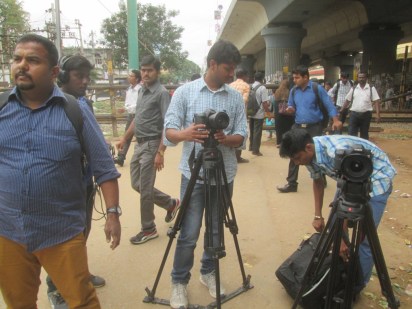 Bengaluru Every trip is an education. Every trip to India is a contradiction.
Bengaluru Every trip is an education. Every trip to India is a contradiction.
The Chennai train station had free wi-fi for one hour, but so few seats that most people sat on the floor. The Bengaluru airport is almost new, build by a French company on a 20-year concession before it will be claimed by the government, so in the city that bills itself the Silicon Valley of India, there’s no wi-fi, or basically none, since the promise of something comes from the giant Indian monopoly, Tata, for 45 minutes, accessible by a text message to your nonexistent local phone. Perhaps worse, flying from Bengaluru to Delhi to journey home a bag checked in Bengaluru would have to be reclaimed in Delhi, because the domestic and international terminals are a 20 minute or more bus trip apart. Let’s not make it easy to come or go in India.
Of course being dropped at the airport in Bengaluru is still the easy road home. Suresh Kadashan, ACORN India’s director in south India left me at the airport to have the car roll him home for a minute and then to the train station to make a 5:00 rail to a city at the very border of Karnataka and Maharashtra, fourteen hours away on the train, to deal with the threatened closing of a market there for ten days which would
devastate our members. I’ll be over the Atlantic Ocean halfway to Newark before he shows up at 7AM.
We were both relieved to be on our way to the next ports of call though in some ways, not because of the work or the problems postponed, like this big market crisis, but because for major parts of four days we were joined by various locally contracted crews for two different documentary films in various stages of completion somewhere between help and hope. Both sets of directors promised faithfully that their interest was simply to follow us around, being virtually invisible so they could capture the truth of our work. The reality was wildly different, though all were well intentioned, we were organizing somewhere near the theater of the absurd. In some cases the photographers were clueless, unable to navigate the local languages in either Chennai or Bengaluru, while expecting we would feed and ferry them about. In others situations they confused documentary for high drama, and we were asked to stage tourist gawking, bus riding, and any manner of other scenes, we politely declined. We had directors hither and yon that we had to remind repeatedly that we were organizers. All meant well, and no doubt, all will end well, but what a relief to be free of our one-eyed camera shadows and their various helpers! What an experience – never again!
On the other hand, this morning at the flyover market, I was able to study carefully the process where one of our leaders, and alternately his father, made giant, thin dosas that looked exactly like giant, thin pancakes coming off the grill. They are made of rice flour though and in many ways the texture is more like a crepe. It was hard not to imagine cranking them out as a specialty of our coffeehouses in New Orleans with
cinnamon, sugar, and any manner of other treats. Talking to our vendor, between 630 AM and 1130 when he closes he serves more than 400 breakfasts of idlys, dosas, and more to a steady stream of people, charging twenty rupees for a full place and ten rupees for a half-plate, essentially between a 20 and 35 cents USD for the meal. They look like hotcakes, and they sold like hotcakes.
Summer in India runs between March and May before the monsoons come. A daughter of one man we met was out of school. Our vendor’s father was helping during the dry season before returning to his village to plant. Summer is waiting for me on the other end of this trip once I hit the south again, but otherwise the world awaits, ever changing.

